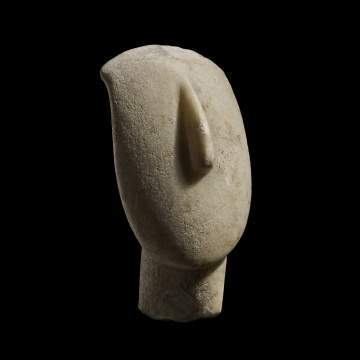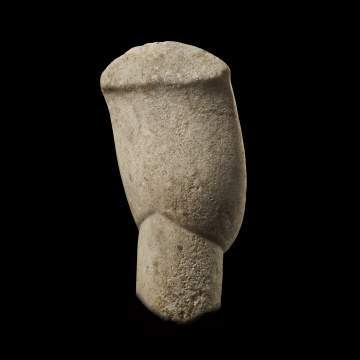

Hammer Price w/ BP
$188,800
| Lot #: 236 A Large Cycladic Marble Head |
|
Late Spedos Variety, Early Cycladic II, ca. 2500-2400 BC Once crowning an exceptionally large figure measuring 20 in (52 cm) or more in height, this head is a prime example of the elegance achieved by Cycladic sculptors of the 3rd millennium BC. The lyre-shaped, slightly convex head has broad cheeks, a long aquiline nose set high up, a rounded and shallow chin, and a delicate “finial” preserved on the right corner. Running across the high sloping forehead are traces of a painted band that continues on the back and from which curly hair locks, similarly rendered in paint, once descended; it was not uncommon for Spedos sculptures to have details, such as hair and various markings on the face and body, added in red, blue, and black pigments. The long neck is elegantly contoured all the way around the head, terminating in a reverse V-shaped articulation at the base of the spine. |
| Ht. 5 5/8 in (14.3 cm) |
|
Provenance Dr. C. A. Best (1931-1978), Toronto, Canada, acquired in or before 1975, possibly late 1960s – early 1970s Mrs. DuVal Cravens, Buffalo, New York, acquired in 1979 from the Little Museum, Toronto, from the estate of Dr. C. A. Best |
|
Condition As seen with no restorations; bottom right edge of neck, nose ridge and edge of left side of forehead chipped, wear throughout with ghost lines, a bit of discoloration and likely calcium carbonate deposits on the back. Dr. Pat Getz-Gentle described it as “impressive” and positively vetted it. |
|
Auction Date Sep 22, 2017 |
Details:
These so-called Cycladic figurines or idols come from the homonymous Greek island chain in the Aegean Sea, where they were discovered in select graves. They almost certainly fulfilled a religious function that largely eludes us today, but probably involved fertility and rebirth as the figurines are often pregnant.
In the early 20th century, artists such as Picasso, Modigliani, and Brancusi admired and were deeply influenced by the Cycladic aesthetic in their work. The economy of form and reduction to essential geometry deeply resonated with the spirit of the time and contributed particularly to the development of Cubism. The constructivist shapes that articulate such images resonate deeply in the human psyche, evoking a direct and powerful reaction today as much as they did five thousand years ago.
The lot is accompanied by the original sale documents issued by the gallery, signed by its director, S. Ogden, and dated January 22, 1979, one of which mentions an appraisal of the head on August 22, 1975.
Dr. Charles Alexander Best was a member of the Canadian Parliament and a son of Dr. Charles Herbert Best, one of the co-discoverers of insulin.
Mrs. DuVal (Annette) Cravens (1923-2017) belonged to a distinguished philanthropic family from Buffalo, New York. She donated most of her archaeological and ethnographic collection to the State University of New York at Buffalo, where it is now publicly displayed.
For expertise, condition, and provenance enquiries, please contact Luciano deMarsillac at [email protected], or at 917-523-0900 (+1 from outside the United States).
In the early 20th century, artists such as Picasso, Modigliani, and Brancusi admired and were deeply influenced by the Cycladic aesthetic in their work. The economy of form and reduction to essential geometry deeply resonated with the spirit of the time and contributed particularly to the development of Cubism. The constructivist shapes that articulate such images resonate deeply in the human psyche, evoking a direct and powerful reaction today as much as they did five thousand years ago.
The lot is accompanied by the original sale documents issued by the gallery, signed by its director, S. Ogden, and dated January 22, 1979, one of which mentions an appraisal of the head on August 22, 1975.
Dr. Charles Alexander Best was a member of the Canadian Parliament and a son of Dr. Charles Herbert Best, one of the co-discoverers of insulin.
Mrs. DuVal (Annette) Cravens (1923-2017) belonged to a distinguished philanthropic family from Buffalo, New York. She donated most of her archaeological and ethnographic collection to the State University of New York at Buffalo, where it is now publicly displayed.
For expertise, condition, and provenance enquiries, please contact Luciano deMarsillac at [email protected], or at 917-523-0900 (+1 from outside the United States).
Shipping Information:
Unlike many auction companies, Cottone Auctions offers a full-service shipping department. We’re equipped to pack and safely ship just about any item to just about any location around the globe.
Learn more >


